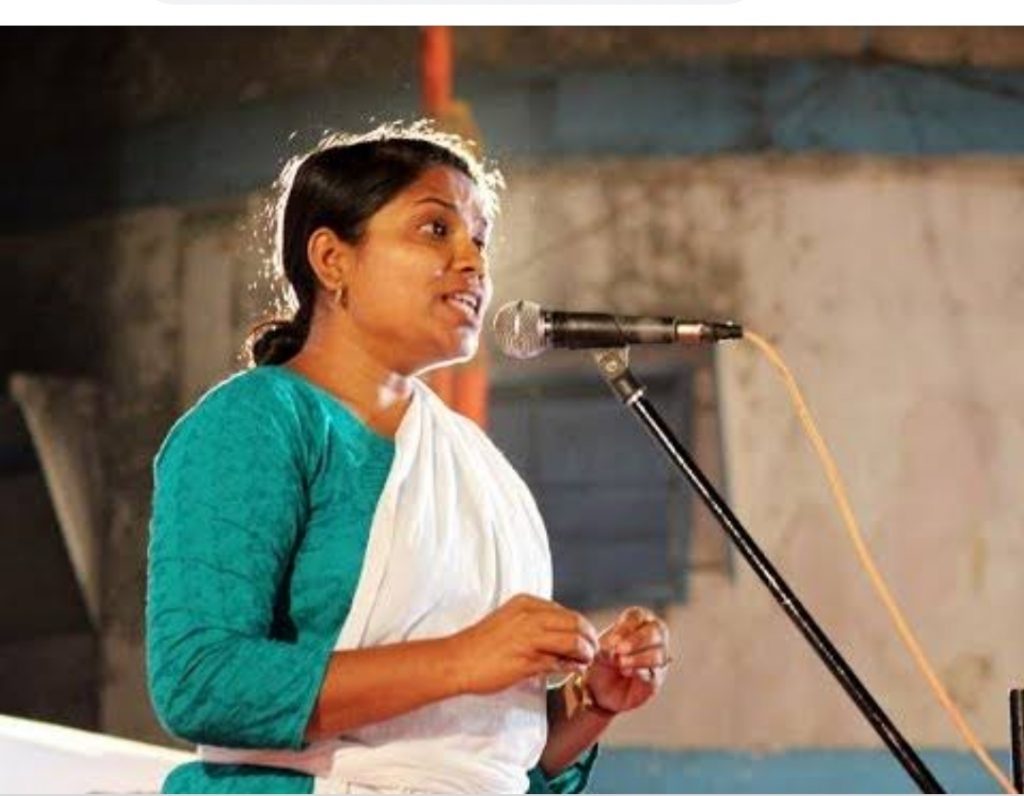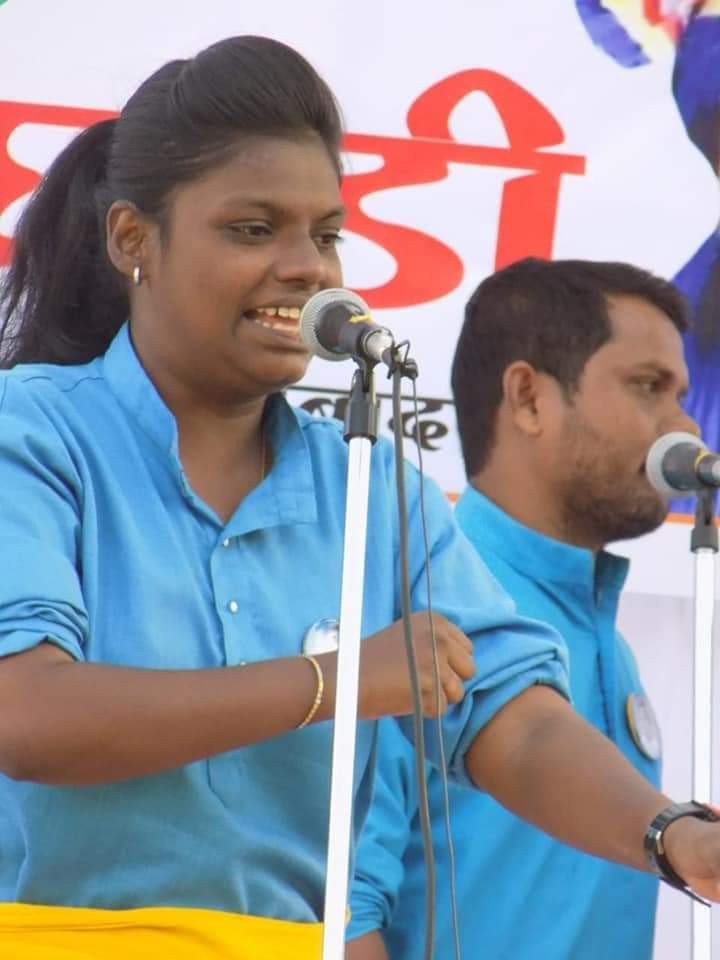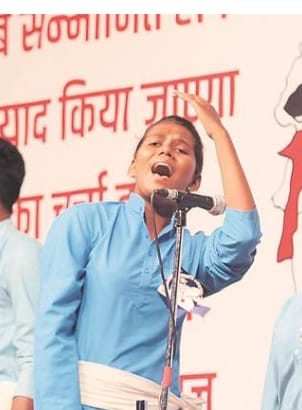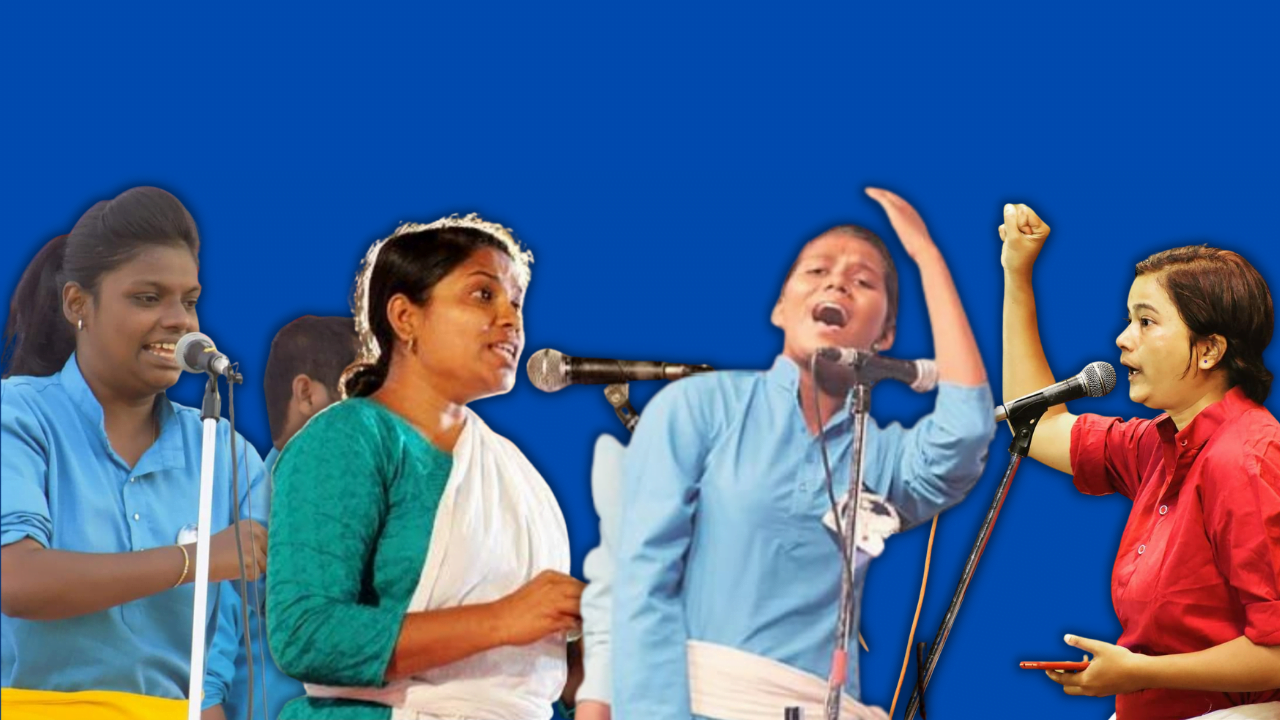Maharashtra has an important and prominent history of Shahiri, a traditional art form originating in the 18th century. It is derived from the art form “Tamasha” which is entertainment for upper castes and is performed by Dalit men and women, primarily from Mahar, Matang, and Mang communities.
Shahiri troupes are also an important part of contemporary movement of Dalit women. Below are a few Shahir women with notable contribution in the contemporary anti-caste movement in Maharashtra.
Read part one: Dalit Shahir: Maharashtra’s Traditional Anti-Caste Art Form
1. Sheetal Sathe
Sheetal Sathe in her interview to the Marathi news channel talks about her journey in the movement.
When she was in college, she came in contact with activists from Kabir Kala Manch and music for which she have had a liking towards since childhood. There was a tradition of music in her home, her mother and grandparents would sing devotional songs, and that helped cultivate a cultural understanding in Sheetal. “We did not have a tradition of education in my home but my mother felt strongly that her children should study and make a name for themselves, so she enrolled me in a school.“, Sheetal said. During college, she made acquaintances outside her circle. On 3rd January, Savitrimai Phule’s birth anniversary, there was a program where she saw Sambhaji Bhagat perform and saw Phule Wada for the first time. After that she joined Kabir Kala Manch and started participating in exchanges of thought.

“I always had Babasaheb’s thoughts with me but then I was acquainted with Marxist thought as well. My comrades from Kabir Kala Manch contributed a lot to the development of my personality,” she said
Then she too started writing songs! When she would perform songs about Babasaheb and inflation in bastis, she would get a great response from people. After stepping into the movement, she decided to marry Sachin Mali of Kabir Kala Manch. Since it was an intercaste marriage,both their families opposed it. Only her mother was present for her wedding and from his family, his father, elder brother, and sister were present. His mother opposed the wedding since Sheetal belong to the Mang caste, but still they decided to marry.
Through Kabir Kala Manch, they visited several places and did the work of dissemination of knowledge and anti caste work through the medium of song. After Khairlanji, they toured the entirety of Maharashtra thinking to themselves, how much longer to bear these injustices and atrocities? It is time to question the government directly. The government in turn persecuted them and accused them of being Maoists and threw them in jail when Sheetal was pregnant.
Also read: Why Dalit Women’s Contribution Needs Assertion Today
On 4 June 2013, the Mumbai Sessions Court denied their petition for bail. Finally, on 28 June 2013, Bombay High Court released Sheetal Sathe on humanitarian grounds.
“Those days were extremely difficult days, I received bail but my partner Sachin Mali was still in jail. Later, with our baby, I started campaigning for his release,” Sheetal agonised.
Note: After leaving Kabir Kala Manch, Sachin and Sheetal now work with a group called Navayan Mahajalsa and have no connection whatsoever with Kabir Kala Manch.
2. Rupali Jadhav
“I had heard filmy songs but had never heard songs about inflation, zopadpatti (ghettos), workers, Dalits, or labouring mothers. I heard them from Kabir Kala Manch and they moved me, and then I started working with Kabir Kala Manch. Another important reason was that Kabir Kala Manch would act the way they spoke. They were not just Shahirs but also workers in the movements. That’s why I joined them,” said Rupali while talking about how she joined the cultural troupe.

She shared that her journey as a Shahir has been very difficult. The persecution she faced was difficult for our entire group. They were fewer women in the group and so it was difficult to talk about patriarchy with other activists or while singing their songs. As a Dalit woman, she had to struggle to assert her thoughts inside the group as well as outside in the society. “When one works in the movement, the personal is the political – whatever happens with our politics reflects in our personal lives,” she said.
Also read: The Hierarchies In The Women’s Reservation Bill, Feminist & Dalit Movements
Rupali’s experience shows that for a Dalit person continuing to be vocal about their rights as a human being is not an easy battle, while sharing about the same she said, “Every single day, I have to fight state persecution and that fight is financial, psychological and physical. Since I am an activist, it is extremely difficult to get a job and even if I get one, because my involvement and presence is required for the movement, it becomes impossible to hold on to it. That’s why the financial struggle is constant. As a Dalit women, I know that this system is ready to sacrifice you at any point, because Dalit women are soft targets for this system.”
3. Suvarna Salve
Suvarna Salve is an activist with Samata Kala Manch and has been working with the Dalit Ambedkarite movement since ten years. While sharing her experience as an anti-caste Shahir, she said, “Because I am Dalit, Babasaheb is a part of our lives. That’s why, since I understood that there is still caste-based injustice and oppression in this country, I started feeling that I must be a part of achieving Babasaheb’s goals. There were caste based atrocities committed on Meera Kamble, a Dalit woman, and around the same time, I had attended a performance by Republican Panthers, an organisation doing anti-caste work. I saw their Shahiri Jalsa at Byculla and was very inspired by their work. The manner in which these Shahirs, through their songs, were laying bare the condition of society and raising awareness among people about why caste should end really struck me. I too decided that I wanted to do the same work and create awareness about social problems among people.”
“Especially when women appreciate your work and want to be close to you, it fills you with motivation and strength to go on and fight against the caste system, the Brahmin system, and the patriarchy.” Shahir Suvarna expressed.
Her journey with Republican Panthers began from there. The first campaign she worked on was the Nitin Aage case. Nitin Aage was murdered by upper caste people because they suspected that he was in love with an upper caste girl. Because of this suspicion, they cruelly murdered him. Through Republican Panthers, Suvarna campaigned for justice for Nitin. “We campaigned, we took out rallies, went into bastis and created awareness about the case,” she said. After that, they ran several such campaigns, from Satyabhama Tai Suryavanshi and caste atrocities committed against her or Rohit Vemula’s institutional murder. Through Republican Panthers, she became a part of many such efforts for justice. In 2017, they named our cultural unit as ‘Samata Kala Manch’.

“Through art, we stood with people’s struggles, be it injustice against Dalit communities in Una or Najeeb Ahmed’s disappearance in JNU, we have raised our voices each time. Samata Kala Manch has run campaigns in Mumbai during the anti CAA-NRC movement as well,” Suvarna shared.
Suvarna also shared her experience during campaigning on the ground that when she as a woman Shahir would go to basits with a dafli in her hand and talk about the condition of society, they would shower her with love, care, and affection. “Especially when women appreciate your work and want to be close to you, it fills you with motivation and strength to go on and fight against the caste system, the Brahmin system, and the patriarchy,” she expressed.
Also read: 6 Forgotten Dalit, Bahujan And Adivasi Women Who Fought For India’s Independence
Suvarna said that this journey was not the easy and she had to struggle a lot to convince her participation in the movement as a Shahir from her family to society. “I started staying out late at night because of my activism and performances. Because this society is patriarchal, it can’t tolerate a woman going out and working. The mindset is that women should only worry about the kitchen and the child. I opposed all this as I became part of the movement. I could do it only because my mother and sister always supported me. Because of their support, I would give a fitting reply to this Manuvadi system that only wants to enslave me,” she asserted.
“Along with this, when you work in the anti-caste movement, this system constantly tries to pull you back and persecute you. Sometimes they will mark you as a habitual offender and sometimes they will slap you with a notice of Rs 50 lakh. But I won’t stop my work because the thought that I fight for is my inheritance and I can never let it go. Today, 16 people are behind bars in the Bhima Koregaon case. Sudhir Dhawale of Republican Panthers, Sagar Gorkhe, Ramesh Gaichor and Jyoti Jagtap of Kabir Kala Manch – these are my idols. My thoughts match Babasaheb’s and Jyotiba-Savitribai’s vision and that is why the Brahmanical order can never scare me or pull me back. My fight will always continue through the medium of art,” she continued.
4. Samiksha Maurya
Samiksha works with Samata Kala Manch, an Ambedkarite cultural organisation. Sharing about her journey as a Shahir she said, “I was born in a system/society where my speech, my behaviour, the extent of my independence is decided not by me but by the society. If I want to be free of all this, society itself has to be free. Shahiri is a form of resistance where you forge a bond with the public and that bond becomes a way of sharing our joys and trials with each other. Whenever the patriarchal mindset of the society tries to silence me, a Dalit woman, I feel suffocated and angry and I realise that this pain is not just mine but of every single woman here. And if I want to articulate this frustration, anger, and all of these sensations, then converting them to shahiri gives them a double edge.”

Samiksha believes that as a woman, when she was in need of a space and a space where she gets the right to speak, behave, write and articulate freely, she got this platform in the cultural movement – a cultural movement which works to end caste, class, and women’s enslavement. “Once I was a part of the movement, I saw people working on not just these, but countless other subtler struggles. It is like ruthlessly exposing this Brahmanical culture in public,” she said.
Each one of their songs and their voice touched my heart. And I was certain that if I wanted to escape these traditions and dogma, I too must speak out.
Shahir Sameeksha Maurya
Sharing about the discrimination she faced she said, “Dalit people usually have a darker complexion and because I am Dalit, I too am the same since birth. That is why, I have an inferiority complex about my skin colour. I was constantly demotivated because I do not fit into Brahmanical beauty standards. But while working in the movement, writing confidently and exposing and rejecting these beauty standards proved to be inspiring and challenging at the same time.”
Also read: Revisiting Deccan Development Society: A Tale Of Dalit & Marginalised Women Saving The Environment
Her journey as a Shahir began with a Kabir Kala Manch performance when she saw Shahir Ramesh Gaichor and Shahir Sagar Gorkhe sing. “Each one of their songs and their voice touched my heart. And I was certain that if I wanted to escape these traditions and dogma, I too must speak out,” she recalled.
After that she joined Samata Kala Manch where she started singing and writing songs. She started expressing her anger through her songs. She believes that joining the group helped in increasing her confidence and she found even more strength when she spoke to others who stood by the people in each one of their struggles. She emphasised that the fight and participation of women in the CAA-NRC movement gave her consistent affirmation that the work she is doing is right.
“I am giving all I have to this work of ending caste and women’s enslavement and I will continue to do so,” she promised herself.
Megha Kshirasgar is an Ambedkarite Cultural Activist and is a member of Samata Kala Manch. She did Masters in Social Work (Dalit and Tribal Studies and Action) from Tata Institute of Social Sciences, Mumbai. You can find her on Facebook and Instagram.
The article was originally written in Marathi, translated in English by Sanika Dhakephalkar.





